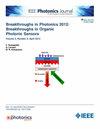Gate-Tunable Photovoltaic Behavior and Polarization-Sensitive Near-Infrared Photodetector Based on GeS2/MoTe2 Heterostructure
IF 2.4
4区 工程技术
Q3 ENGINEERING, ELECTRICAL & ELECTRONIC
引用次数: 0
Abstract
Self-powered photodetectors, which operate without the need for an external power supply, play a pivotal role in addressing the growing demands for low power consumption, environmental sustainability, and device miniaturization. These next-generation photodetectors have garnered significant attention due to their exceptional attributes, including high photoresponsivity, low dark current, and rapid photoresponse. GeS2 and MoTe2 materials, owing to their unique structural characteristics and superior optoelectronic properties, have been extensively explored for self-powered photodetection applications. In this work, we present a gate-tunable photovoltaic behavior and polarization-sensitive near-infrared (NIR) photodetector based on GeS2/MoTe2 heterojunction. Under 850 nm illumination with an incident power density of 63.42 mW/cm2, the device exhibits a high responsivity of 1.09 A/W and a specific detectivity of 1.42 × 1010 Jones at zero bias, along with a fast response time of 56 ms. By applying a gate voltage, the photovoltaic performance can be effectively modulated, with the responsivity enhanced to 8.3 A/W and the detectivity improved to 1.09 × 1011 Jones under a gate bias of –8 V. Furthermore, due to the anisotropic optical properties of GeS2, the device demonstrates pronounced polarization sensitivity. Leveraging its outstanding NIR performance, the GeS2/MoTe2 photodetector is integrated into a multiband antibiotic concentration detection system, enabling efficient, accurate, and eco-friendly monitoring of antibiotic levels.基于GeS2/MoTe2异质结构的栅极可调谐光伏行为和偏振敏感近红外光电探测器
自供电光电探测器无需外部电源即可运行,在解决对低功耗、环境可持续性和设备小型化日益增长的需求方面发挥着关键作用。这些下一代光电探测器因其高光响应性、低暗电流和快速光响应等特殊特性而受到广泛关注。GeS2和MoTe2材料由于其独特的结构特征和优越的光电性能,在自供电光探测应用中得到了广泛的探索。在这项工作中,我们提出了一种基于GeS2/MoTe2异质结的栅极可调谐光伏行为和偏振敏感近红外(NIR)光电探测器。在850 nm入射功率密度为63.42 mW/cm2的照明下,器件具有1.09 a /W的高响应率和1.42 × 1010 Jones的零偏比探测率,以及56 ms的快速响应时间。通过施加栅极电压,可以有效地调制光伏性能,在栅极偏置为-8 V时,响应度提高到8.3 a /W,探测率提高到1.09 × 1011 Jones。此外,由于GeS2的各向异性光学特性,该器件具有明显的偏振灵敏度。利用其出色的近红外性能,GeS2/MoTe2光电检测器集成到多波段抗生素浓度检测系统中,实现高效,准确和环保的抗生素水平监测。
本文章由计算机程序翻译,如有差异,请以英文原文为准。
求助全文
约1分钟内获得全文
求助全文
来源期刊

IEEE Photonics Journal
ENGINEERING, ELECTRICAL & ELECTRONIC-OPTICS
CiteScore
4.50
自引率
8.30%
发文量
489
审稿时长
1.4 months
期刊介绍:
Breakthroughs in the generation of light and in its control and utilization have given rise to the field of Photonics, a rapidly expanding area of science and technology with major technological and economic impact. Photonics integrates quantum electronics and optics to accelerate progress in the generation of novel photon sources and in their utilization in emerging applications at the micro and nano scales spanning from the far-infrared/THz to the x-ray region of the electromagnetic spectrum. IEEE Photonics Journal is an online-only journal dedicated to the rapid disclosure of top-quality peer-reviewed research at the forefront of all areas of photonics. Contributions addressing issues ranging from fundamental understanding to emerging technologies and applications are within the scope of the Journal. The Journal includes topics in: Photon sources from far infrared to X-rays, Photonics materials and engineered photonic structures, Integrated optics and optoelectronic, Ultrafast, attosecond, high field and short wavelength photonics, Biophotonics, including DNA photonics, Nanophotonics, Magnetophotonics, Fundamentals of light propagation and interaction; nonlinear effects, Optical data storage, Fiber optics and optical communications devices, systems, and technologies, Micro Opto Electro Mechanical Systems (MOEMS), Microwave photonics, Optical Sensors.
 求助内容:
求助内容: 应助结果提醒方式:
应助结果提醒方式:


